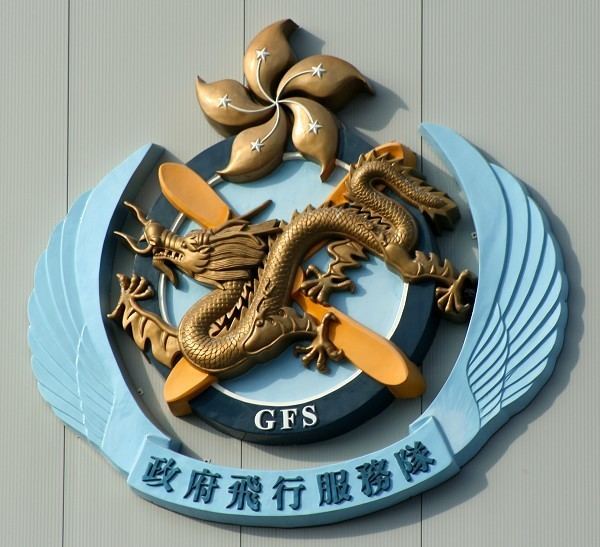Formed 1993 Employees 225 | Jurisdiction Hong Kong | |
 | ||
Minister responsible Lai Tung-kwok, Secretary for Security | ||
The Government Flying Service (GFS) is a disciplined unit of the Government of Hong Kong. It was established on 1 April 1993, when Hong Kong was under British rule. It then took over all the non-military operations of the Royal Hong Kong Auxiliary Air Force (RHKAAF), which was an auxiliary unit of the United Kingdom Royal Air Force. After Hong Kong was handed over to the People's Republic of China in 1997, the GFS remains as a government unit of the Hong Kong Special Administrative Region (HKSAR), and is responsible for search and rescue (SAR), air ambulance, firefighting and police operations.
Contents
- Operations
- Fleet
- Retired fleet
- Aircraft on Order
- Equipment and Gear
- Personnel
- Uniform
- Rank
- Controllers
- Crest
- GFS in the media
- Incidents
- References
The service operates from the southwestern end of Hong Kong International Airport at Chek Lap Kok. Before the opening of the Chek Lap Kok airport in 1998, it operated from the old Kai Tak Airport (i.e. the former Hong Kong International Airport). GFS patrols a 400-nautical-mile (740 km) radius of Hong Kong's Maritime Search and Rescue Region, as well as the Hong Kong Flight Information Region (FIR), which covers most of the South China Sea basin.
In 2007, the former dispersal in the old Kai Tak Airport was re-opened as a sub-base, providing refuelling and other supporting services for GFS's helicopters. The helipad is located near the foot of Cheung Yip Street.
Operations
GFS is broken down to operational sections:
Helicopters can land on 5 highways in Hong Kong to attend to road related recovery operations. For long-range search and rescue operations, the GFS initially uses fixed wing aircraft which then guides helicopters to the location.
Fleet
The fleet currently comprises:
Paint scheme for Jetstream and Super Puma is white and Safety orange, two grey (night black and sea grey) tones for the EC 155 and some of the Super Puma to support police operations (tactical troops transport).
In 2015, Government Flying Service placed orders for 7 Airbus Helicopters H175 aircraft, for which it will be the launch customer. Delivery is expected in 2017 and 2018.
Retired fleet
The fleet has previously included:
Aircraft on Order
The following aircraft are on HKGFS's Orderbooks
Prior to 2002, the fleet colours consisted of:
Equipment and Gear
Standard equipment for GFS personnel is:
As the GFS is not a police or para-military unit, they are unarmed. Armed officers of the Hong Kong Police Force fly with the GFS on occasion.
Personnel
GFS employs 238 personnel:
Most of the pilots in the GFS were localised prior to the handover in 1997, as former RAF and other British military personnel departed Hong Kong.
The GFS is led by a controller, who reports to the Secretary for Security. The current controller is Captain Michael CP Chan.
Other senior officers of the GFS are:
Uniform
Operations uniforms:
Dress uniforms:
Rank
Prior to the creation of the GFS, the ranks within the Royal Hong Kong Auxiliary Air Force were the same as the RAF. The late 1980s and early 1990s saw the transition to local staff in the RHKAAF in preparation for the civil transfer to the GFS role. For details and insignia of the ranking, see http://www.gfs.gov.hk/eng/insignia.htm
Ranking of personnel of the GFS are civilian aviation roles and are as follows:
Pilot II and Cadet Pilot ranks were created in the 1990s for local pilots with less flying experience.
Controllers
List of past controllers of the GFS:
Crest
The current crest of the force was adopted in 1997, prior to which the Hong Kong Coat of Arms was used on GFS aircraft:
